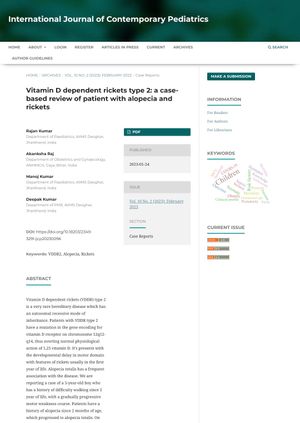Vitamin D Dependent Rickets Type 2: A Case-Based Review of a Patient With Alopecia and Rickets
January 2023
in “
International Journal of Contemporary Pediatrics
”

TLDR A rare genetic disease causes rickets and often hair loss in young children, which can improve with specific treatments.
Vitamin D dependent rickets (VDDR) type 2 is a rare hereditary disease with an autosomal recessive mode of inheritance, often presenting with developmental delay in motor skills and features of rickets in the first year of life. It is frequently associated with alopecia totalis. The case study focuses on a 5-year-old boy with a history of difficulty walking since he was 2 years old, and alopecia since he was 2 months old, which progressed to alopecia totalis. His serum calcium was 7.2 mg/dl, and he had a very high alkaline phosphate level of 1065 IU/ML, but a normal vitamin D level. Treatment included IV calcium, 1000mg of oral calcium, and a high dose of calcitriol, which led to improvement in biochemical parameters. A review of seven other patients found that 5 had alopecia, 2 had enamel hypoplasia, and all had features of rickets.